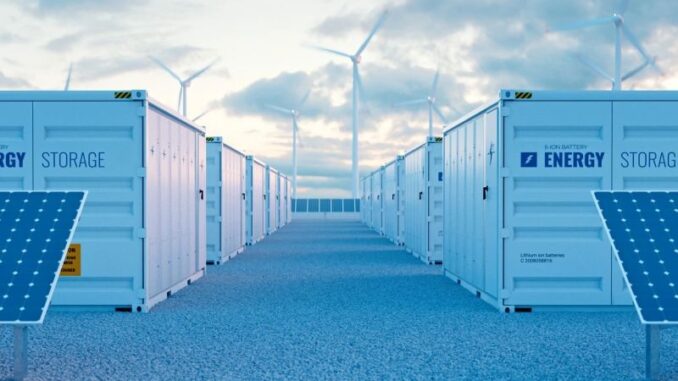
In a move poised to reshape Illinois’ energy landscape, Governor JB Pritzker is set to sign the Clean and Reliable Grid Affordability (CRGA) Act, a sweeping energy reform package passed by the state legislature in late October 2025.
The bill, which cleared both the House and Senate amid heated debate, mandates the deployment of 3 gigawatts (GW) of battery energy storage systems (BESS) by 2030, alongside incentives for geothermal energy, virtual power plants, and the lifting of a decades-long moratorium on new large-scale nuclear reactors.
Proponents hail it as a critical step toward grid reliability and cost savings, but critics warn of immediate bill hikes, highlighting a partisan divide on its economic impacts.
Illinois’ Current Energy Mix: A Nuclear-Heavy Portfolio with Growing Renewables
Illinois has long been a powerhouse in U.S. energy production, serving as a key exporter and hub for electricity.
As of 2025, the state’s electricity generation mix is dominated by nuclear power, which accounts for approximately 52-54% of output, making Illinois the nation’s top nuclear producer.
Fossil fuels still play a significant role, with natural gas contributing 17-30% and coal around 15-30%.
Renewables have surged in recent years, now generating 13-16% of in-state electricity—nearly triple the share from a decade ago—with wind as the primary source at about 10-11%.
Solar is growing rapidly, expected to increase by over 1,700% in capacity over the next five years, driven by policies like the 2021 Climate and Equitable Jobs Act (CEJA) aiming for 100% clean energy by 2050.
This mix positions Illinois as the third-highest state in carbon-free electricity generation, thanks largely to its nuclear fleet.
However, recent surges in electricity bills—attributed to grid operators’ rate hikes and fossil fuel volatility—have spurred the CRGA Act, which seeks to integrate battery storage to stabilize supply and reduce reliance on expensive peaker plants.
The Bill’s Key Provisions: Batteries at the Center
The CRGA Act focuses on enhancing grid resilience through energy storage. It requires utilities to procure 3 GW of BESS by 2030 (with some reports specifying 2031), funded via a new surcharge on consumer bills.
This builds on Illinois’ existing renewable goals, including 40% renewables by 2030 under CEJA. The bill also empowers regulators with new tools to scrutinize utility spending and incentivizes virtual power plants, where aggregated home batteries and demand-response tech can feed power back to the grid.
Investments in battery projects are projected to total around $7 billion, with costs passed to ratepayers through the surcharge.
State subsidies include grants of about $110,000 per megawatt (MW) of installed capacity, with $280.5 million in total funding available.
Federally, the Investment Tax Credit (ITC) under the Inflation Reduction Act provides a 30% credit on BESS costs, especially when paired with solar, plus bonuses for domestic content.
Reports from groups like the Natural Resources Defense Council (NRDC) estimate the act could save Illinois households and businesses up to $13 billion over time by curbing price spikes and enabling cheaper renewable integration.
Partisan Disagreements: Will Bills Go Down or Up?
The bill’s passage exposed a stark divide between Democrats and Republicans on its financial implications. Democrats, including Governor Pritzker, argue that the investments will yield long-term savings by improving grid efficiency, reducing transmission losses, and avoiding costly blackouts or imports during peak demand.
They point to projections of $20.54 in monthly savings per household once the system is operational, driven by batteries’ ability to store cheap renewable energy and discharge it during high-price periods.
State Senator Bill Cunningham, a Democrat, emphasized that the package is “projected to save Illinois households more than $13 billion.”
Republicans, however, decry the bill as a “green energy boondoggle” that will immediately raise rates. They estimate an $8 monthly increase for average consumers to fund the $7 billion in batteries, with the initial surcharge adding 58-68 cents per month—potentially more for businesses.
State Representative Patrick Windhorst called it a guarantee of “higher prices for consumers and businesses,” arguing that subsidies favor utilities over ratepayers.
Opponents, including some bipartisan voices, fear the costs could exacerbate recent bill surges, with little short-term relief.
ROI on Battery Storage: A Mixed Picture
The return on investment (ROI) for BESS projects in the U.S. typically ranges from 3-5 years, depending on market conditions, incentives, and “value stacking”—combining revenue from energy arbitrage, frequency regulation, and demand charge reduction.
In Illinois, average installation costs for a 13 kWh residential system run $18,636-$25,214 before incentives, but the 30% ITC and state grants can shorten payback periods significantly.
Commercial and utility-scale projects often see higher ROI through wholesale market participation, with internal rates of return (IRR) boosted by the IRA’s bonuses.
However, critics question whether Illinois’ surcharge model will deliver timely ROI for consumers, as upfront costs hit bills before savings materialize.
Illinois Electricity Costs Compared to the Top 15 Cheapest States
Illinois’ average residential electricity rate stands at about 15.5 cents per kilowatt-hour (kWh) as of November 2025, below the national average of 15-17 cents/kWh but higher than many low-cost states.
This places it in the middle of the pack, influenced by its nuclear dominance and recent rate hikes. For context, here’s how Illinois compares to the top 15 states with the lowest average residential rates (based on November 2025 data):
|
Rank
|
State
|
Average Rate (cents/kWh)
|
|---|---|---|
|
1
|
North Dakota
|
11.08
|
|
2
|
Idaho
|
11.69
|
|
3
|
Washington
|
11.82
|
|
4
|
Utah
|
11.95
|
|
5
|
Nebraska
|
12.10
|
|
6
|
Wyoming
|
12.25
|
|
7
|
Montana
|
12.40
|
|
8
|
Oklahoma
|
12.55
|
|
9
|
Kentucky
|
12.70
|
|
10
|
Arkansas
|
12.85
|
|
11
|
Louisiana
|
13.00
|
|
12
|
South Dakota
|
13.15
|
|
13
|
Iowa
|
13.30
|
|
14
|
Tennessee
|
13.45
|
|
15
|
Missouri
|
13.60
|
|
–
|
Illinois
|
15.50
|
(Data compiled from EIA and state reports; national average: 17.01 cents/kWh).
States like North Dakota benefit from abundant coal and hydro resources, keeping rates low. Illinois’s higher costs stem partly from transmission fees and fossil fuel dependencies, which the CRGA Act aims to mitigate through storage.
Looking Ahead: Uncertainty Amid Ambition
As Governor Pritzker prepares to sign the bill, Illinois stands at a crossroads. The 3 GW battery mandate could accelerate the state’s clean energy transition, potentially lowering long-term prices by integrating more renewables and stabilizing the grid.
Yet, the partisan rift underscores a key uncertainty: Will the upfront costs—borne by ratepayers—translate to tangible savings, or will they exacerbate affordability issues? Reports suggest net benefits over a decade, but ROI timelines and price reductions remain speculative. For Illinois residents, the proof will be in their monthly bills.
The bill does not include the end-of-life or recycling of batteries in the budget.
The funding mechanism established by the Clean and Reliable Grid Affordability (CRGA) Act for procuring 3 GW of battery energy storage systems (BESS)—primarily a new surcharge on electric utility customers’ bills—does not explicitly include or allocate resources for end-of-life retirement, decommissioning, or recycling fees.
This surcharge is designed to cover upfront procurement and installation costs, with projections estimating total investments around $7 billion passed through to ratepayers.
State-level subsidies, such as grants of approximately $110,000 per megawatt of installed capacity (totaling $280.5 million available), also focus on deployment rather than post-lifespan handling.
No provisions in the bill text synopses, fact sheets, or related reports reference inclusion of these end-of-life costs in the funding stream.
Instead, end-of-life responsibilities for BESS in Illinois are governed by local county ordinances, which require project owners or operators to submit decommissioning plans and provide financial assurances (e.g., bonds, letters of credit, or escrow funds) to cover removal, site restoration, and recycling upon the end of the project’s useful life or abandonment.
These plans must be updated periodically (e.g., every few years), with cost estimates accounting for salvage value, labor, and environmental remediation. Failure to comply can result in penalties or denial of permits. This approach ensures costs are borne by the developers rather than taxpayers or ratepayers directly through state funding.
The manufactured lifespan of grid-scale BESS, predominantly lithium-ion technologies like lithium iron phosphate (LFP) or nickel manganese cobalt (NMC), typically ranges from 10-20 years.
This varies based on factors such as charge-discharge cycles (often 4,000-6,000 cycles before 80% capacity degradation), depth of discharge, operating temperatures, and maintenance.
In utility-scale applications with one daily cycle, this often translates to 10-15 years of optimal performance before refurbishment or replacement is needed, though some systems are warranted for 10 years and can last 25+ years with upgrades.
End-of-life is generally defined as when capacity drops below 70-80% of original, at which point batteries may be repurposed for less demanding uses or recycled.
So, as we see the article, now that Bill Gates has said that Climate Change is not our biggest existential threat to Humanity, how much money has he cost the global markets?, How much will consumers be willing to keep adding to their bills for “green energy” that excludes end-of-life costs in the projects?







Be the first to comment